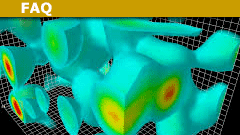What are Virtual Particles? A 10 Minute Introduction
Table of Contents
Definition/Summary
Virtual particles are a mathematical device used in perturbation expansions of the S-operator (transition matrix) of interaction in quantum field theory.
No virtual particle physically appears in the interaction: all possible virtual particles, and their antiparticles, occur equally and together in the mathematics and must be removed by integration over the values of their momenta.
In the coordinate-space representation of a Feynman diagram, the virtual particles are on-mass-shell (realistic), but only 3-momentum is conserved at each vertex, not 4-momentum, so there is no immediate way of obtaining 4-momentum-conserving delta functions.
In the momentum-space representation, the virtual particles are both on- and off-mass-shell (unrealistic), but 4-momentum is conserved at each vertex, and also round each loop (as shown by a delta function for each).
In the coordinate-space representation, each virtual particle appears “as itself”, but in the momentum-space representation, it is represented by a “propagator” (a function of its 4-momentum).
Equations
The calculation for an “H”-shaped Feynman diagram for the interaction between an electron and a photon with given incoming and outgoing 4-momentums, and with “exchanged” 4-momentum [itex]Q = (\boldsymbol{Q},E)[/itex]:
The “centre part” of the transition probability is:
[tex]\frac{1}{(2\pi)^3}\ \int\frac{d^3\boldsymbol{q}}{2\sqrt{\boldsymbol{q}^2\ +\ m^2}}\ \int\ d^3(\boldsymbol{x}_1-\boldsymbol{x}_2)\ \int\ d(t_1-t_2)\ \ e^{i(E(t_1-t_2)-\boldsymbol{Q}\cdot(\boldsymbol{x}_1-\boldsymbol{x}_2))}\ e^{i\boldsymbol{q}\cdot(\boldsymbol{x}_1-\boldsymbol{x}_2)}[/tex]
[tex]\times\ \left(\theta(t_1-t_2)\ e^{-i\sqrt{\boldsymbol{q}^2\ +\ m^2}(t_1-t_2)}\ (\gamma_{i}\boldsymbol{q}^{i}+ \gamma_{0}\sqrt{\boldsymbol{q}^2\ +\ m^2}+im)\right.[/tex]
[tex]\left. +\ \theta (t_2-t_1)\ e^{i\sqrt{\boldsymbol{q}^2 \ +\ m^2}(t_1-t_2)}\ (\gamma_i\boldsymbol{q}^i+ \gamma_{0}\sqrt{\boldsymbol{q}^2\ +\ m^2}-im)\right)[/tex]
(the integral is over all virtual electrons with 3-momentum [itex]\boldsymbol{q}[/itex] created on the left of the “H”, and all virtual positrons with 3-momentum [itex]\boldsymbol{q}[/itex] created on the right, and [itex]\theta(t)\ =\ 1\text{ if }t > 0\ \text{ but }=\ 0\text{ if }t < 0[/itex]) [tex]=\ \frac{1}{(2\pi)^3}\ \int\frac{d^3\boldsymbol{q}}{2\sqrt{\boldsymbol{q}^2\ +\ m^2}}\ \int\ d^3(\boldsymbol{x}_1-\boldsymbol{x}_2)\ e^{i((\boldsymbol{q}-\boldsymbol{Q})\cdot(\boldsymbol{x}_1-\boldsymbol{x}_2))}\ \int\ d(t_1-t_2)[/tex] [tex]\times\ \left(\theta(t_1-t_2)\ e^{i(E-\sqrt{\boldsymbol{q}^2\ +\ m^2})(t_1-t_2)}\ (\gamma_{i}\boldsymbol{q}^{i}+ \gamma_{0}\sqrt{\boldsymbol{q}^2\ +\ m^2}+im)\right.[/tex] [tex]\left.+\ \theta(t_2-t_1)\ e^{i(E+\sqrt{\boldsymbol{q}^2\ +\ m^2})(t_1-t_2)}\ (\gamma_{i}\boldsymbol{q}^{i}- \gamma_{0}\sqrt{\boldsymbol{q}^2\ +\ m^2}+im)\right)[/tex] (where in the terms with [itex]\theta(t_2-t_1)[/itex] we have replaced [itex]\boldsymbol{q}\text{ and }d^3\boldsymbol{q}[/itex] by [itex]-\boldsymbol{q}\text{ and }-d^3\boldsymbol{q}[/itex]) [tex]=\ \lim_{\varepsilon\rightarrow 0+}\frac{1}{(2\pi)^3}\ \int\frac{d^3\boldsymbol{q}}{2\sqrt{\boldsymbol{q}^2\ +\ m^2}}\ \delta^3(\boldsymbol{q},\boldsymbol{Q})\ \int\ d(t_1-t_2)[/tex] [tex]\times\ \frac{-1}{2\pi i}\ \left(\ (\gamma_i\boldsymbol{q}^i+ \gamma_0\sqrt{\boldsymbol{q}^2\ +\ m^2}+im)\ \int\frac{e^{i(E\ -\ \sqrt{\boldsymbol{q}^2\ +\ m^2}\ -\ s)(t_1-t_2)}}{s\ +\ i\varepsilon}\,ds\right.[/tex] [tex]\left.+\ \ (\gamma_i\boldsymbol{q}^i-\gamma_0\sqrt{\boldsymbol{q}^2\ +\ m^2}+im)\ \int\frac{e^{i(E\ +\ \sqrt{\boldsymbol{q}^2\ +\ m^2}\ +\ s)(t_1-t_2)}}{s\ +\ i\varepsilon}\,ds\right)[/tex] (here, a fictional energy variable, [itex]s[/itex], has been introduced, enabling [itex]\theta(t)[/itex] to be replaced by [itex]\lim_{\varepsilon\rightarrow 0+}(-1/2\pi i)\int e^{-ist}ds/(s+i\varepsilon)[/itex]) [tex]=\ \lim_{\varepsilon\rightarrow 0+}\frac{1}{(2\pi)^3}\ \frac{1}{2\sqrt{\boldsymbol{Q}^2\ +\ m^2}}[/tex] [tex]\times\ \frac{-1}{2\pi i}\ \left(\ (\gamma_i\boldsymbol{Q}^i+ \gamma_0\sqrt{\boldsymbol{Q}^2\ +\ m^2}\ +\ im)\ \int\frac{\delta(s,E- \sqrt{\boldsymbol{Q}^2\ +\ m^2})}{s\ +\ i\varepsilon}\,ds\right.[/tex] [tex]\left.+\ \ (\gamma_i\boldsymbol{Q}^i-\gamma_0\sqrt{\boldsymbol{Q}^2\ +\ m^2}\ +\ im)\ \int\frac{\delta(s,-E-\sqrt{\boldsymbol{Q}^2\ +\ m^2})}{s\ +\ i\varepsilon}\,ds\right)[/tex] [tex]=\ \lim_{\varepsilon\rightarrow 0+}\frac{-1}{(2\pi)^4\,i}\ \frac{\gamma_i\boldsymbol{Q}^i\ +\ im}{2\sqrt{\boldsymbol{Q}^2\ +\ m^2}}\left(\frac{1}{E-\sqrt{\boldsymbol{Q}^2\ +\ m^2}\ +\ i\varepsilon}\ +\ \frac{1}{-E-\sqrt{\boldsymbol{Q}^2\ +\ m^2}\ -\ i\varepsilon}\right)[/tex] [tex]+\ \frac{-1}{(2\pi)^4\,i}\ \frac{\gamma_0}{2}\left(\frac{1}{E-\sqrt{\boldsymbol{Q}^2\ +\ m^2}\ +\ i\varepsilon}\ -\ \frac{1}{-E-\sqrt{\boldsymbol{Q}^2\ +\ m^2}\ -\ i\varepsilon}\right)[/tex] [tex]=\ \frac{1}{(2\pi)^4\,i}\ \frac{\gamma_i\boldsymbol{Q}^i\ +\ \gamma_0E\ +\ im}{\boldsymbol{Q}^2\ -\ E^2\ +\ m^2}\ =\ \frac{1}{(2\pi)^4}\ \frac{-i\,Q\hspace{-1.0ex}/\ +\ m}{2mk_0}[/tex] where [itex]k_0[/itex] is the (non-zero!) final energy of the photon, measured in the reference frame in which the initial electron is stationary, and [itex]Q\hspace{-1.0ex}/\ =\ \gamma_{\mu}Q^{\mu}\ =\ \gamma_i\boldsymbol{Q}^i\ +\ \gamma_0E[/itex].
Extended explanation
Dyson (perturbation) expansion:
The nth order of the Dyson expansion of the S-operator includes a time-ordered product of n copies of the Hamiltonian, evaluated at n different 4-positions (events): [itex]T\{H(x_1)\cdots H(x_N)\}[/itex] “Time-ordered” means that the copies are re-arranged in order of their t-components, with the earliest on the right. For example, if [itex]t_3>t_1>t_2[/itex], then [itex]T\{H(x_1)H(x_2)H(x_3)\}\ =\ H(x_3)H(x_1)H(x_2)[/itex]
Although time-ordering is generally not Lorentz-invariant, it is for non-spacelike pairs of events, and therefore is for Hamiltonians, provided that they commute at spacelike pairs: [itex]H(x_1)H(x_2)\ =\ H(x_2)H(x_1)\text{ if }(x_1-x_2)^2>0[/itex]: see Weinberg, (3.5.13-14)
Each copy is the sum (integral) of products of (usually) three operators: they are the creation or annihilation operator for three particles of fixed type (for example, two electrons or positrons, and a photon).
These types must be one particle which is not its own anti-particle (with two operators), such as an electron, and one particle which is (with one operator), such as a photon, or three particles which are.
This sum is over every possible 3-momentum for each particle and its anti-particle, each evaluated at the same 4-position: [itex]H(x_n)\ =\ \int \boldsymbol{a}(m,\boldsymbol{p},x_n) \boldsymbol{a}(m’,\boldsymbol{p}’,x_n) \boldsymbol{a}(m”,\boldsymbol{p}”,x_n) \,d\boldsymbol{p}\,d \boldsymbol{p}’\,d \boldsymbol{p}”[/itex]
These particles are known as virtual particles. They are not created or destroyed in the actual interaction: they appear only in mathematics.
On-mass-shell virtual particles:
These virtual particles are realistic: in other words, they can exist: after all, only particles that can exist can have creation or annihilation operators! :wink:
Being realistic, each such particle is on-mass-shell (or “on-shell”): the energy is fixed by the 3-momentum: [itex]E^2\ =\ \boldsymbol{p}^2\ +\ m^2[/itex], where [itex]m[/itex] is the standard mass for that particle.
Same on-mass-shell virtual particle at each end of every line:
The two virtual particles (on-mass-shell), one with a creation operator on one side of an internal line in a Feynman diagram, and one with an annihilation operator on the other side must be the same.
This is because a product [itex]H(x_1)\cdots H(x_N)[/itex] is zero unless every creation operator at one 4-position is “matched” by its own annihilation operator at another 4-position: these matches are represented by internal lines joining each such pair of points. By definition, therefore, a Feynman diagram must have each internal line “matched”.
So if the 3-momentum is [itex]\boldsymbol{q}[/itex] on one side, it must be [itex]-\boldsymbol{q}[/itex] on the other side.
“Phase” at each vertex:
Each particle at a vertex [itex]x_n[/itex] is associated with a “phase” [itex]e^{ip\cdot x_n}[/itex], where [itex]p[/itex] is its 4-momentum.
Each vertex is associated with a different value of [itex]x_n[/itex] (a 4-vector), and the three particles (literally) connected to that vertex all share that value, so that all three produce a combined “phase” such as [itex]e^{i(p\ -\ k’\ -\ q)\cdot x_n}[/itex].
Dirac Delta functions:
The importance of the combined “phase” at each vertex is that it may be replaced by a Dirac delta function, provided that it is integrated over all possible values of [itex]x_n[/itex].
This is because the “phase” oscillates if the factor [itex](p\ -\ k’\ -\ q)[/itex] is non-zero, but is a constant ([itex]1[/itex]) if the factor is zero (for all values of x). The oscillations make the integral zero if [itex](p\ -\ k’\ -\ q)[/itex] is non-zero, and the constant, [itex]1[/itex], makes the integral the same as if the “phase” was not there if [itex](p\ -\ k’\ -\ q)[/itex] is zero, apart from a factor of [itex]2\pi[/itex].
Therefore, the “phase”, and the integral over [itex]x_n[/itex], can both be replaced by the symbol [itex]\delta(p\ -\ k’\ -\ q)[/itex] (a Dirac delta function), which has the effect of eliminating all versions of the diagram except those in which the total momentum at the vertex is zero. This is another way of saying that 4-momentum is conserved at the vertex.
Unfortunately, in the coordinate-space representation, the diagram cannot be integrated over all possible values of x, because values of the t-component of x which are less than the t-component of y (the value for the other vertex) are not allowed for virtual particles (and values that are greater are not allowed for virtual anti-particles).
For each allowed value of the t-component, all values of the other three (“spatial”) components are allowed, and so the 3-momentum (only) is conserved, but this is of no immediate use.
Only when this time-ordering restriction is removed (by the mathematical trick of including unrealistic particles) can the diagram be integrated over all possible values of x and y, thereby conserving 4-momentum.
Dirac delta function is not a function
The Dirac delta function is not a function but a distribution.
It only makes sense in the middle of an integral: it reduces the number of variables to be integrated over while imposing constraints on the eliminated variables.
Coordinate-space representation:
Each internal line [itex]x_jx_i[/itex] in the coordinate-space representation represents the creation and annihilation operators of every possible particle and anti-particle. These particles and anti-particles are realistic (on-mass-shell): each obeys the self-energy-momentum equation [itex]E^2\ =\ \boldsymbol{p}^2\ +\ m^2[/itex].
The particles are created at [itex]x_i[/itex] and annihilated, later, at [itex]x_j[/itex]. The anti-particles are created at [itex]x_j[/itex] and annihilated, earlier, at [itex]x_i[/itex].
It is arbitrary which we call a particle and which an anti-particle: we usually call the positron an anti-particle, but we can call the electron an anti-particle instead if we adjust the Hamiltonian accordingly.
A photon, of course, is its own anti-particle.
They are all virtual in the sense that none of them is actually created and annihilated: the diagram is a mathematical device, and must be integrated (summed) over the 3-momentum of every possible realistic particle and anti-particle, and also overall time-ordered values of [itex]x_i[/itex] and [itex]x_j[/itex].
Momentum-space representation:
The trick which removes the time-ordering restriction is the introduction of a new phase, combining the time coordinate with a new energy variable [itex]s[/itex]: together with the original 3-momentum variable(s), this gives a new four-component variable [itex]q \ =\ (\boldsymbol{q},s)[/itex] which behaves as a 4-momentum, and appears in a combined phase of the form [itex]e^{i(q-Q)\cdot(x_j-x_i)}[/itex], which disappears when integrated over [itex]x_j-x_i[/itex], to be replaced by a delta function [itex]\delta(q,Q)[/itex], multiplied by a propagator (a function of [itex]q[/itex]).
For a simple example, see Equations above, in which the propagator is [itex](-i\,q\hspace{-0.8ex}/\ +\ m)/(q^2\ +\ m^2\ -\ i\varepsilon)[/itex]. This case is simpler than usual, since the delta functions in this case eliminate the need to integrate over [itex]q[/itex].
An “H”-diagram has been chosen, rather than the similar “stick-man” diagram since it involves a virtual electron rather than a virtual photon: this is partly to avoid the complications of gauge theory, and partly to emphasize that the electromagnetic interaction is not mediated solely by virtual photons. :wink:
A different variable 4-momentum [itex]q[/itex] is assigned to each internal line. Since they do not have the standard mass appropriate to their line (they have every possible mass), they are called off-mass-shell, and may also be considered the 4-momentums of a virtual particle.
Again, these are virtual in the sense that none of them is actually created and annihilated: indeed, most of them (unlike the coordinate-space virtual particles) could not exist, since they do not have the mass of an actual particle.
The diagram must be now integrated (summed) over the 4-momentum of every realistic and unrealistic particle and anti-particle, but not over the coordinate values, [itex]x_1,x_2,\cdots x_n[/itex], since these have been replaced by delta functions.
This elimination of the coordinates, and of the need to integrate over them, justifies the change of name from “coordinate-space representation” to “momentum-space representation”.
Casimir effect:
Would someone like to contribute a comment on the Casimir effect?
Avoiding off-mass-shell virtual particles:
In principle, the mathematical device of off-mass-shell virtual particles (and the whole momentum-space representation) can always be avoided, but in practice the calculations will usually be horrendous. In the simple example above, however, we could easily have avoided them by using the substitutions [itex]t = (E-\sqrt{\boldsymbol{q}^2\ +\ m^2})(t_1-t_2)[/itex] and [itex]t = (E+\sqrt{\boldsymbol{q}^2\ +\ m^2})(t_1-t_2)[/itex] at the beginning, giving:
[tex]\int\ dt\ \times\ \left(\theta(t)\ e^{it}\ (\gamma_{i}\boldsymbol{q}^{i}+ \gamma_{0}\sqrt{\boldsymbol{q}^2\ +\ m^2}+im)\left/(E-\sqrt{\boldsymbol{q}^2\ +\ m^2})\right.\right.[/tex]
[tex]\left.+\ \theta(-t)\ e^{it}\ (\gamma_{i}\boldsymbol{q}^{i}- \gamma_{0}\sqrt{\boldsymbol{q}^2\ +\ m^2}+im)\left/(E+\sqrt{\boldsymbol{q}^2\ +\ m^2})\right.\right)[/tex]
and then using [itex]\theta(t)+\theta(-t) = 1[/itex] and so [itex]∫(Ae^{it}\theta(t)+Be^{it}\theta(-t))dt = (A+B)/2[/itex], thus achieving the same final result.
This article was authored by several Physics Forums members with PhDs in physics or mathematics.




Not exactly the same, but you can compare this to the square of an imaginary number – it is negative, too.